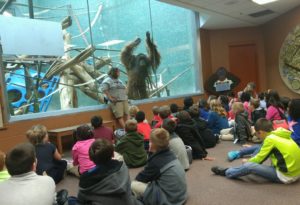Rotational Exhibit Strategy
The natural world offers variety…naturally. If you went on a safari you might see a giraffe or a lion or an elephant. You might not get to see them when you had hoped or even in the order you had hoped. Animals in the wild simply don’t adhere to the predictable schedules that we humans love. That is the inspiration for the more contemporary and future zoo animals exhibits — where animals rotate in and out of varied habitat spaces at unpredictable times. The Louisville Zoo was actually the first to implement this type of exhibit design and animal care strategy with the award-winning Islands exhibit. You could say it’s our signature brand. Gorilla Forest also follows this approach as does Glacier Run. All three exhibits have been recognized by the Association of Zoos and Aquariums as exemplary models of exhibit design and have been granted significant achievement awards.
Why rotation? At the end of the day it is about keeping it fresh and enriching for these highly anticipatory and smart creatures, “Rotating their habitats gives animals lots of variety,” says Supervisor of Animal Training Jane Anne Franklin. “Animals may pick up on any routines very quickly and start anticipating events like feeding times if we don’t change things up a good bit. Non-scheduling more closely mimics what they would do in nature — and that helps keep them active and curious.”
Because there are more species in a rotational exhibit than public-facing habitats, one or more animals are often off-exhibit for a phase during the multiple daily rotations. This strategy offers keepers additional training and bonding time with the animals off-exhibit. Franklin explains that “rotation gives us an opportunity to have quiet training sessions with them where we are teaching and observing and just spending time with our animals building trust.”
You may wonder what the animals do when they aren’t on exhibit. One of the philosophies here at the Louisville Zoo is that we build our behind-the-scenes (or bedroom) spaces to be comparable in size to the public-facing exhibit spaces. That means that all those spaces are an extension of each other in the animals’ eyes. “Our human perception sees outside as being the place the animals want to be, when maybe they really prefer to spend some time inside with similar activities and just hanging out watching us perform our daily care duties,” says Franklin. The animals get the same high-quality enrichment activities to engage them in their bedrooms as they do when they are on public exhibit.
So just remember: if you don’t see the animals you think you’re going to see where you saw them before, be sure to come back. Your experience will likely be different every time! If you see no animals, just hang out for a few minutes as you may have arrived during an actual rotation.
How does rotation work, technically?
 A series of overhead, at grade or below grade transfer aisles are configured to allow
A series of overhead, at grade or below grade transfer aisles are configured to allow
safe passage of animals from holding areas into the indoor and outdoor exhibits. This
allows maximum flexibility to situate the animals in any habitat and also provides protection to the teams of keepers orchestrating the complex series of transfer doors.
Transfer mechanisms also provide flexibility in animal management, enabling keepers to group or segregate animals as needed to facilitate animal health and safety.
 Safety First! This is the Zoo’s mantra. Keepers always work in teams when they are engaged with any dangerous animals. You will notice that each device has an animal icon painted on it to ensure keepers know which species in involved in a rotation.
Safety First! This is the Zoo’s mantra. Keepers always work in teams when they are engaged with any dangerous animals. You will notice that each device has an animal icon painted on it to ensure keepers know which species in involved in a rotation.
Training is paramount. If you’ve had a pet and wanted it to go exactly where you wanted, when you wanted, you know training (usually with food) in involved. Our Islands keepers are experts at behavioral training and much of their expertise has developed as a result of our rotational exhibit design. Use of operant conditioning is key to smooth operation and participation/ cooperation of both new and veteran animals.





